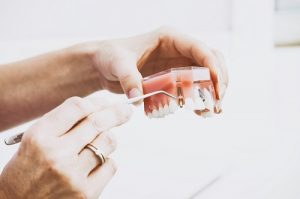If you are missing teeth, need teeth extractions, or struggle with severe tooth decay, dentures may be the right option for you. They are not only able to restore your ability to talk and eat with ease, they are also a realistic prosthetic that can improve the look of your smile and give you back your self-confidence.
When discussing dentures as an option with our patients, our restorative dentist is often asked things like, “What are dentures made of?” or “How are dentures made?” To clear up any questions you might have and help you learn a bit more about them, we’re going to share an in-depth look at dentures – what they are, where they started, and what dentures are like today!
When Were Dentures First Used?
 False teeth, or dentures, are one of the oldest forms of dentistry, dating back 7th Century BC where archaeologists found skulls with dentures made of a mix of human and animal teeth. While the structure of them changed, animal and human teeth were used to create dentures up through the 1800s. These were often considered a temporary fix as the animal and human bone would wear away or break over time. Finally, with the invention of porcelain dentures in 1770, a more permanent, fitted solution was created and available for sale to the public in 1792.
False teeth, or dentures, are one of the oldest forms of dentistry, dating back 7th Century BC where archaeologists found skulls with dentures made of a mix of human and animal teeth. While the structure of them changed, animal and human teeth were used to create dentures up through the 1800s. These were often considered a temporary fix as the animal and human bone would wear away or break over time. Finally, with the invention of porcelain dentures in 1770, a more permanent, fitted solution was created and available for sale to the public in 1792.
Through the 1800s and 1900s, porcelain was the commonly used material to create teeth, while the plates themselves were created from gold originally, followed by Vulcanite, which is a type of hardened rubber. Through the 20th century, innovations in plastics, acrylics, and resin led to the growth of using acrylic resin to make dentures, both the plate and the teeth.
We also want to add that while the legend of George Washington having wooden teeth is well known, it’s actually untrue. His dentures were made of a blend of lead, ivory, and human teeth.
What Are Dentures Made of Today?
Today’s dentures are primarily made from a hybrid composite of resin, generally acrylic. Acrylic is a strong, long-lasting plastic that offers a comfortable, lightweight feel, and because it’s easy to shape to the impressions, users will generally achieve a comfortable fit with few adjustments needed. Acrylic is also not as hard as porcelain so it won’t damage natural teeth, so it’s a good option to use to create bridges or partials.
One of the main reasons acrylic resin is so widely used is due to cost. Dentures made from acrylic are significantly less expensive than porcelain, making them more accessible. Also, this material can be used to make the plates or framework of the denture. Plates made from acrylic can be tinted to look more like natural gums, so wearing dentures is less likely to be noticeable.
While acrylic is definitely the more common material, porcelain is still used in some cases, especially when someone requires a full set of dentures. This is a hard, highly durable ceramic material that has a similar feel and appearance to natural teeth so wearers find it easier to adapt to them. However, they are heavy and cost-prohibitive to many people, making them used only in specific situations. Porcelain dentures are often paired with a chrome or metal framework which is both durable and can provide a more snug fit.
How Are Dentures Made?
When it’s determined that a patient would benefit from wearing dentures, the dentist uses a sticky paste in trays or wax to make an impression in order to get a mold of their upper and lower gums. This ensures an accurate fit so the framework fits comfortably.
The impressions are sent to a lab to make the dentures, where the process begins. First, a plaster model is made from the impressions to create a realistic shape of your mouth. The model is then placed in an articulator, which is a device that mimics the action and movements of a jaw. This allows the technician to attach the teeth to the model using wax.
Once the teeth are placed, the technician shapes the gums to look natural and fit the impressions accurately. The teeth are placed into a type of flask and plaster is added to hold the shape of the teeth. As it hardens, the wax is then melted away.
After the technician rinses the teeth to ensure there’s no residual wax leftover, the acrylic is injected to replace the wax. This forms the frame of the teeth and is left to cure. Once it’s cured, the plaster is removed and the teeth are cleaned to remove any leftover plaster. Finally, the acrylic is trimmed and the teeth are polished. Then, they are sent back to your restorative dentist to ensure the proper fit.
Contact Us to Schedule a Denture Consultation
If you have missing or severely damaged teeth, dentures may be the right option for you. Innovations in restorative dentistry mean that dentures fit better, last longer, and look more realistic and natural than ever before.
We have worked with countless people in both Cary and Holly Springs, designing and fitting them with comfortable, attractive dentures and partials to help them regain their comfort and confidence. Schedule a checkup with us today by filling out the form below, by calling our Cary office at 919-467-2203 or Holly Springs office at 919-600-6262.

